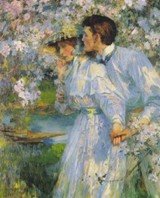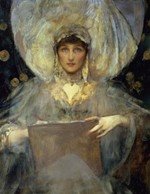James Jebusa Shannon
Irish Portrait Artist. Biography, Paintings.
![]()
![]()
|
James Jebusa Shannon |
 In The Springtime |
James Jebusa Shannon RA (1862-1923)The eminent Irish portrait painter James Shannon, was born in New York, in 1862, the son of Irish immigrants, moving to Ontario, Canada in his early teens, where he had his first art lessons in drawing from William E Wright a local painter. In 1878, he moved to England and studied drawing and painting at the South Kensington School of Art - now the Royal College of Art - under Sir Edward Poynter. In 1880, Shannon won the gold medal for figure painting in the annual competition involving all the art schools in England, becoming Poynter's top pupil. |
 Portrait of Violet, Duchess Of Rutland |
|
PORTRAIT ART IN
IRELAND MORE ABOUT ART IN
IRELAND |
Immediately thereafter, he received a royal commission from Queen Victoria to paint the portraits of the Hon. Horatio Stopford and Mrs Henry Bourke, which were duly exhibited at the Royal Academy (RA) in 1881 and 1882. Both portraits attracted wide attention and more commissions followed. In 1887, Shannon's portrait of Henry Vigne was one of the successes of the RA, later winning Shannon a series of awards at Paris, Berlin and Vienna. During the mid 1880s, James Shannon, along with his fellow artist John Singer Sargent, dominated British portraiture. Shannon's own popularity was enhanced by the patronage of Violet Manners, later Marchioness of Granby. In 1892, he purchased a substantial studio in Holland Park Road in West London where he lived for the rest of his life. In 1897, he was elected an associate of the Royal Academy, and a full academician in 1909. |
|
|
The popularity of Shannon's portrait art was due to his ability to paint portraits that appealed to the aesthetic taste of the time. He adopted the more broken brushwork of modern French painting, while at the same time employing the compositional devices of eighteenth-century academic art, all with style and bravura. In 1904 he travelled to New York with his wife and daughter for the first of three extended stays (1905, 1906, 1907), where he had several solo exhibitions at the Knoedler Gallery. He was a regular exhibitor at the Royal Academy, the Grosvenor Gallery, the New Gallery and the Royal Institute of Oil Painters. He was a founder member of the New English Art Club in 1886, became President of the Royal Society of Portrait Painters (1910-1923) and was knighted in 1922. He died in 1923 at the age of 61. After he died, memorial exhibitions were held at the Leicester Galleries in London, as well as the Albright Art Gallery and the Cincinnati Museum, in America. Along with Sir John Lavery and Sir William Orpen, Shannon was one of the most notable Irish portrait artists of the nineteenth and twentieth century, and his works are represented in many major museums including the Metropolitan in New York. |
|
More Information About Visual Arts in Ireland • For details of other portrait painters,
see: Irish Artists: Paintings and Biographies. History
of Irish Art |